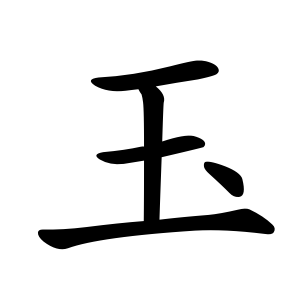玉
- bead jade, bead;
- precious thing, beautiful thing, etc;
Etymology
It is a pictograph representing several jade beads strung together on a cord.
The character 玉 looks like the character 王 (king) with an added dot. This dot was added after the clerical script (隸書 lìshū) period to help distinguish 玉 from 王, as the two characters became very similar in form during the seal script (篆書 zhuànshū) period. Originally, 玉 and 王 had no resemblance, but both evolved into the current 王 shape, making them hard to differentiate.
Specifically, in 玉, the second horizontal stroke is perfectly centered between the first and third strokes, while in 王, the second stroke is slightly higher, making the gap between the second and third strokes larger. In clerical script, this difference blurred further, so the dot was added to 玉 for clarity.
Usage in Korean
When 玉 is used as a radical, it is sometimes written like 王 due to this similarity.
Originally, 玉 referred strictly to a jewel or precious stone (jade), without a general meaning for all round objects. Over time, the meaning expanded to include spherical objects.
In Middle Korean, 玉 was pronounced as 구술 (區戌), as recorded in the 15th-century text 석보상절.
Alternative forms
Characters with 玉
Words that derived from 玉
- 一土戈 (MGI)
- ⿱ 一 圡
- ⿷ 王 丶
